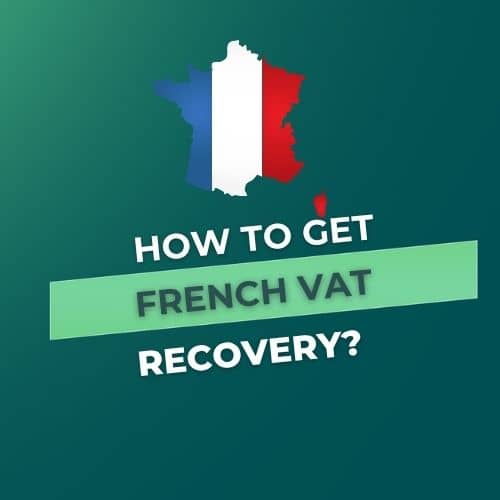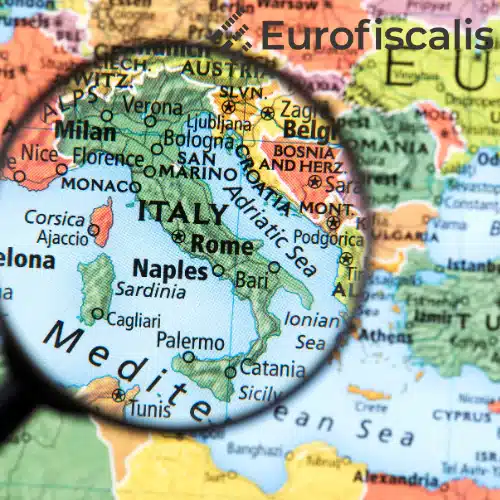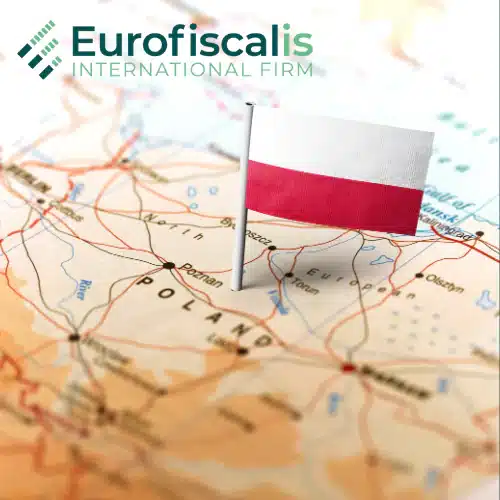Invoicing in Poland - do it right
This article about invoicing in Poland covers all of the needed aspects. You will understand current regulations and prepare for the transition of electronic invoicing. The article explores key elements of Polish invoicing and e-invoicing, including the upcoming mandatory KSeF system. Gain the knowledge that your business needs and issue invoices with confidently.
- Published on :
- Reading time : 15 min
Quick introduction to invoicing in Poland
Whether you’re a Polish entrepreneur or a foreign company doing business in Poland – navigating a country’s invoicing requirements can often feel like traversing a complex landscape, and Poland is no exception.
For businesses operating within or trading with Poland, you have to master the rules of compliant invoicing – if you want to have smooth operations, VAT compliance, and ultimately, financial health.
As Poland switches to digital fiscality, this brings a significant shift with increasing importance of electronic invoicing and the emergence of the National e-Invoicing System – KSeF.
Invoicing in Poland
How to make an invoice in Poland?
To create a compliant Polish invoice, you must include:
- Issue date
- A unique, sequential invoice number (or series of numbers)
- Name and address of the supplier
- Name and address of the buyer
- Tax Identification Number of the supplier (NIP, or Numer Identyfikacji Podatkowej)
- The Tax Identification Number (NIP – Polish VAT number) of the buyer, if they are a VAT taxpayer
- The date of the products or services’ supply, if it differs from the invoice date
- A description of the products or services rendered, including:
- the quantity or scope of the products or services;
- the net price per unit (VAT excluded)
- The applicable VAT rate or rates
- The amount owed in Polish Zloty (PLN) for VAT
- Gross amount, which includes VAT in the total price
Invoices in Poland are usually issued in Polish Zloty – PLN. However, invoices can be issued in foreign currencies, provided that the applicable exchange rate used to convert amounts into PLN is clearly started.
The exchange rate must be published by the National Bank of Poland (NBP) from the last business day preceding the date the tax liability emerged.
What is the process of invoicing in Poland?
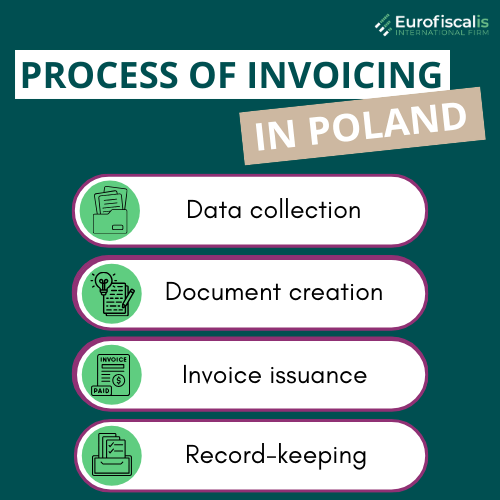
- Data collection – you have to gather all the important information for the invoice (supplier, buyer details, description of the goods/services, VAT rates, quantities, prices)
- Document creation – you create the invoice document – make sure that it includes all the mandatory things that were listed above
- Invoice issuance – you issue your invoice to the customer (electronically – via email as a PDF, or in paper form).
Remember that in the future, with mandatory KSeF, you will issue invoices exclusively through the KSeF platform.
- Record-keeping – you must maintain records of all invoices both issued and received, in case of any accounting purposes, VAT compliance, audits
Deadline for issuing an invoice is no longer than the 15th day of the month following month in which goods/services were delivered/performed.
You can book a free consultation with our VAT experts in time that is suitable for you!
Is e-invoicing mandatory in Poland?
Current status of Polish e-invoicing
Right now e-invoicing in Poland is currently voluntary through the KSeF system for the majority of businesses. Businesses are not yet legally obligated to use KSeF. They can still issue and receive invoices in traditional paper form.
The upcoming mandatory e-invoicing in Poland
As previously mentioned, Poland is transitioning towards mandatory e-invoicing. According to current regulations, e-invoicing through KSeF will become mandatory for most B2B (business-business) domestic transactions in Poland, starting from February 1, 2026.
That means that from this date all of VAT taxpayers who have a registered office of fixed establishments in Poland – will be legally entitled to issue electronic invoices using the KSeF system.
Source: KSeF implementation plan
You can book a free consultation with our VAT experts in time that is suitable for you!
Understanding VAT in the context of invoicing in Poland
Is there VAT or GST in Poland?
Poland uses a Value Added Tax (VAT) system, not a Goods and Services Tax (GST) system. They are both consumption taxes, however they have some structural differences. The Polish term for VAT is Podatek od Towarów i Usług, which is often written as VAT or PTU.

VAT rates in Poland
- The standard rate 23%
- Reduced rate I 8%
- Reduced rate II 5%
It’s really important to apply the correct VAT rate to each item on an invoice, because it directly affects the amount of tax due and the overall invoice amount.
Businesses must stay updated on any changes to Polish VAT rates.
If you want to find out more about VAT registration in Poland check out our article below:
Polish VAT Number - NIP
A crucial element on any Polish invoice is the VAT Identification Number (NIP) – a Polish VAT number. The NIP is a unique identifier assigned to businesses registered for VAT purposes.
The supplier’s NIP and (if the buyer is a VAT payer) the buyer’s NIP must be included on the invoice. This is essential for VAT reporting. For EU companies that are trading with Poland – their EU VAT number is also important.
You can book a free consultation with our VAT experts in time that is suitable for you!
Correcting documents in Poland
Polish corrective invoices
Sometimes there are situations where an invoice that has been issued needs to be corrected. Polish VAT regulations provide a mechanism for this through the use of corrective invoices (faktura korygująca). These are issued to fix errors or any changes in the original invoice, such as:
- Changes in the tax base – price changes, discounts
- Return of goods
- Identification of errors in the original invoice – incorrect quantities, prices, or VAT rates
Corrective invoices must reference the original invoice being corrected and specified the changes being made.
Polish correction notes
Correction notes (nota korygująca) are another type of document that is used to correct invoices, but serve a different purpose than corrective invoices. Unlike corrective invoices, which are issued by the seller, correction notes are issued by the buyer.
Correction notes can only be used to correct specific, limited types of errors related to formal requirements in the original invoice, such as:
- The invoice issue date
- The seller’s or buyer’s name or address
- The seller’s or buyer’s NIP (PL VAT number)
The legal framework for e-invoicing in Poland
The EU eInvoicing Directive (20414/55/EU)
Across much of Europe – including Poland, the foundation of electronic invoices relies on the EU eInvoicing Directive (2014/55/EU). In order to facilitate easier cross-border transactions and encourage the use of e-invoicing, this regulation aims to standardise electronic invoicing throughout the European Union.
Poland has transposed this directive into its national law through the Act of 9 November 2018. This act provides the legal structure for using e-invoices, ensuring businesses that they have the same legal validity as traditional invoices.
The directive also mandates the acceptance of all electronic invoices that comply with the European standard (EN 16931). This ensures that businesses across the EU are able to exchange invoices without any problems.
Polish tax regulations and KSeF
While the EU directive provides a comprehensive structure, the Polish Ministry of Finance plays a significant role in shaping the specific regulations governing Polish invoicing, specifically through the introduction of the National e-Invoicing System (KSeF).
KSeF represents a significant step towards the digitalization of invoicing in Poland. It is the central platform for issuing, receiving, and storing structured e-invoices.
The obligation to use KSeF applies to:
- VAT-registered businesses
- VAT-exempt businesses (with some exceptions)
- Taxpayers identified in Poland for the EU’s One-Stop Shop (OSS)
- Important
KSeF covers only B2B (business-to-business) domestic transactions.
It does not extend to B2C (business-to-consumer) transactions and invoices issued under the OSS or Import One-Stop Shop (IOSS) schemes.
The Polish national e-Invoicing system (KSeF) in detail
What is Polish KSeF?
The Krajowy System e-Faktur (KSeF), known as the National e-Invoicing System, is a centralized, government-operated system developed for managing e-invoices in Poland.
Previously, systems often relied on bilateral agreements between trading partners; KSeF, however, introduces a harmonized, nationwide procedure.
KSeF format
Format is based on XML (Extensible Markup Language) and it defined by logical structure, currently FA(2) – however FA(3) is upcoming. This structured format is crucial for automated processing, ensuring that invoices can be easily read and processed by both the sender’s and the recipient’s accounting systems.
KSeF timeline
KSeF was initially introduced as a voluntary system, which gave businesses the option to use it alongside traditional paper-based invoicing. However, right now the Polish government is transitioning towards mandatory e-invoicing.
The current mandatory date fot KSeF is February 1, 2026. Before this date, businesses can choose if they want to use KSeF or continue with their existing invoicing methods. However, it is important to stay updated via official announcements, as this date may change.
Stages of implementing the Polish new system:
- June 2025 ⇒ Publication of FA(3) logical structure on ePUAP
- June 2025 ⇒ Publication of the KSeF 2.0 API documentation
- July 2025 ⇒ Completion of legislation
- September 2025 ⇒ Open tests of the KSeF 2.0 API
- November 2025 ⇒ Sharing certificates
- November 2025 ⇒ Release of the test version of the KSeF 2.0 Taxpayer Application
- February 1, 2026 ⇒ Mandatory KSeF 2.0 STAGE I – for large taxpayers (above 200 m PLN turnover)
- April 1, 2026 ⇒ Mandatory KSeF 2.0 STAGE II – for other taxpayers except the smallest taxpayers who are digitally excluded
- January 1, 2027 ⇒ for taxpayers whose transactions involve small amounts (up to PLN 450 for a single invoice and up to a total sales value of PLN 10,000 per month)
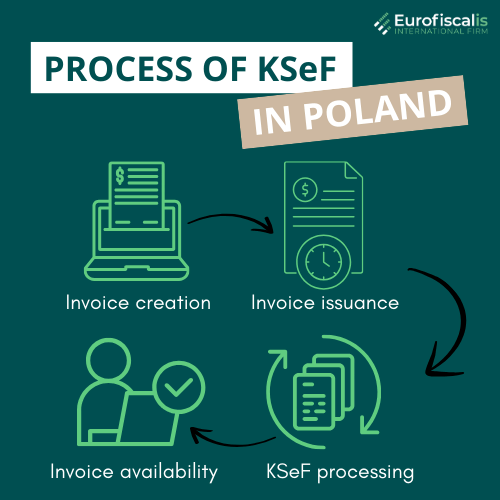
How does the KSeF work?
The process of KSeF:
- Invoice creation – the seller creates an invoice in the required XML format, defined by the FA(2) logical structure (soon transiting into FA(3)) . This can be done using free tools provided by the Polish Ministry of Finance or commercial accounting/ERP software.
- Invoice issuance – the seller submits it to the KSeF platform (instead of sending the invoice directly to the buyer)
- KSeF processing – KSeF confirms the invoice and ensures it meets all of the requirements
- Invoice availability – once confirmed, the invoice is available to both the seller and the buyer through the KSeF system. The buyer can then access and download the invoice from the platform.
What are the benefits of e-invoicing KSeF for Polish businesses
- Efficiency and cost savings
- Improved VAT compliance
- Digitalization and modernization
- Reduced environmental impact
- Improved data accuracy
- Enhanced audit trail
Resources and support for e-invoicing in Poland
Official Polish KSeF resources
The official website of the Polish Ministry of Finance provides access to needed resources, such as:
- Detailed documentation of the logical structure of e-invoices
- User manuals for the KSeF Taxpayer Application
- Technical specifications and guidelines for integrating with KSeF
Support and training
To help businesses prepare for the transitionto mandatory KSeF, the Polish Ministry of Finance and other official organizations offer different forms of support and training, such as:
- Webinars and online tutorials
- Training sessions and workshops
- Helpdesks and support lines
- Publications and guides
Our Polish office provides the following services:
Zosia is a marketing specialist in Eurofiscalis, a company with a well-established position in the field of cross-border VAT compliance. Simultaneously, Zosia continues her academic development as a master’s student in Finance and Accounting, which enables her to stay up-to-date with evolving tax regulations.
Combining her knowledge of marketing with a deep understanding of finance and taxes, creates precise, substantive, and easily accessible content. Her mission is to educate in understanding the complexities of taxation related to doing business in international markets.
With her commitment, Zosia translates complex tax issues into clear language, providing valuable information that genuinely helps companies in their development and international expansion. She aims for tax information to be not only understandable but, above all, helpful in making business decisions.



